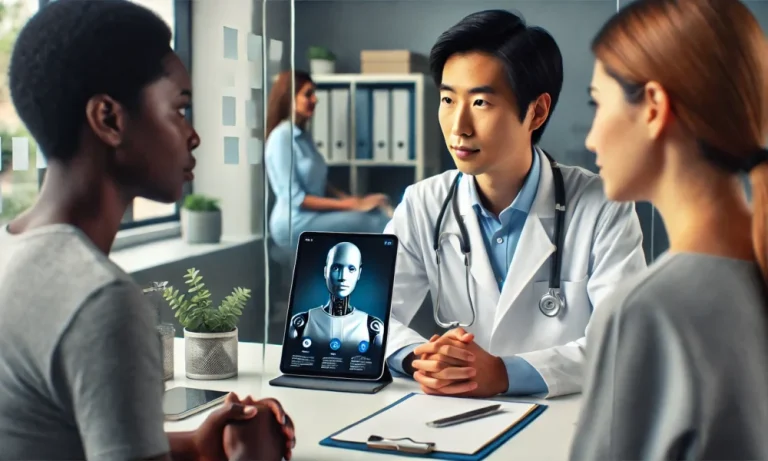The healthcare industry is rapidly entering the next era of its technology-driven story, with AI (Artificial Intelligence) as the main driver. Data shows that 75% of healthcare providers and experts believe that AI-related technologies will be “widely adopted” in the next three years. While industry leaders are still exploring where AI will best benefit patients and healthcare professionals, AI medical scribes for clinical documentation have proven to be an impactful use case that cannot be ignored.
Why is this important for healthcare professionals and patients today?
Since the start of the pandemic, the workload of healthcare professionals has increased significantly. Everything from administrative tasks to patient records puts a huge strain on the lives of healthcare professionals and doctors on a daily basis, causing severe burnout. When asked about the main cause of burnout, nearly two in five people (41%) cited simply long working hours. The healthcare industry is looking for effective technological solutions to meet the growing number and needs of patients and ensure the well-being of doctors.
Another challenge to overcome is helping healthcare professionals get their time back while still providing engaging, compassionate patient care. When patients have a negative experience, they are three times more likely to switch providers. This impacts healthcare providers’ bottom lines and takes a toll on the mental health of employees who are trying to serve their communities.
Streamlining patient care and improving provider efficiency
AI Medical Scribe is a technology that converts natural conversations between healthcare professionals and patients (in person or telehealth) into clinical documentation that can include prescription orders, follow-up appointments, annotations specific to specialty needs, multi-modal notes in addition to traditional SOAP notes, summaries of patient findings, and more.
AI medical transcribers become even more intelligent and intuitive with AI-powered ambient listening technology, which uses natural language processing and advanced AI algorithms to capture conversations in real time and intelligently transcribe them to create dialogue flow. Its ability to capture multiple voices, dialects, and accents makes it essential for multicultural healthcare.
The ambient clinical voice-enabled AI medical recorder creates progress notes for review and assists with record completion, while providing appointment summaries and contextual, real-time patient updates, leading to fast, actionable insights for better care and patient engagement.
Here’s a detailed step-by-step breakdown of how an AI medical transcribe actually works:
When a patient enters the clinic and begins the consultation, the AI Medical Scribe is launched. Once the conversation begins, the AI Medical Scribe listens to the conversation and ensures accurate and efficient information collection. Once the consultation is over, a transcript of the conversation flow is created, recording all speakers who spoke during the consultation. The AI Medical Scribe creates a draft clinical document with the relevant information of the consultation and allows the healthcare professional to edit existing information, enter additional thoughts, next steps, etc. An order entry is generated, and the AI Medical Scribe inserts dialogues and next steps regarding tests, imaging, procedures, medication orders, and follow-up consultation details. The healthcare professional receives a final summary of all information, which they can review for accuracy, make changes if necessary, and merge pre-configured defaults.
An example of an AI medical scribe that is widely used across scale and disciplines is Sunoh.ai, which is integrated into eClinicalWorks EHR and other major EHR systems and is trusted by over 50,000 providers in the U.S. Sunoh.ai is also the first scribe to generate multi-modal notes that capture and interpret a variety of data types to create contextual clinical documentation.
Bridging the Gap: The Promise of AI Medical Scribes
AI medical transcriptors are one of the first widely adopted AI-powered solutions in healthcare to address challenges for both patients and physicians. In addition to bringing economic benefits to healthcare providers and institutions, AI medical transcriptors are secure, reliable, and accurate, thus increasing patient confidence.
The benefits of introducing an AI medical scribe include:
Streamlining clinical documentation: Industry data shows that physicians spend up to six hours each day creating electronic medical records and clinical documentation. AI medical transcripts can drastically reduce that time, allowing them to spend more time with patients. A recent industry survey showed that 51% of healthcare providers believe that AI medical transcripts can save them more than two hours a day. Eliminating physician burnout: There are only so many hours in a day, and streamlining time-consuming tasks like clinical documentation is a great way for physicians to make the most of their time in the day. AI medical transcripts are leading the way in empowering physicians to do their jobs in a more timely and informative manner. Making medical interactions more engaging and human: Because AI medical transcripts act as active listeners and transcripts in the background, physicians can be more focused during consultations. Instead of manually taking notes and entering information, they can focus on immediate responses to patient needs, or “stethoscope time” as some healthcare providers call it. This also translates to patients feeling heard. This is essential to maintaining a satisfied and expanding patient network. Improved accuracy: AI medical scribes reduce the chance of manual errors and fatigue, ensuring accurate and comprehensive patient records. Physicians also manually review progress notes and transcripts, further increasing the accuracy of each entry. More inclusive healthcare tools: Healthcare equity and inclusive care require continuous improvement in the industry. Ambient clinical voice technology can accurately capture different languages, accents, and dialects in meeting transcripts and progress notes. This helps ensure that people seeking care in countries where their native language is not their first language are listened to and better cared for. It also allows us to serve a more diverse patient network.
The future of AI medical transcription
The introduction and adoption of AI medical scribes will kick-start a new intelligent era in healthcare, resulting in a more efficient and accurate healthcare system. Continuous improvements in technology and the onboarding of more healthcare providers will generate even more useful data and use cases that contribute to the continuous improvement of medical documentation. In doing so, the healthcare industry will see increased patient satisfaction and reduced burnout. As healthcare continues to embrace the innovations of AI medical scribes, opportunities will extend beyond clinical documentation. Each action brings us closer to more comprehensive, interactive, and engaging patient care.



